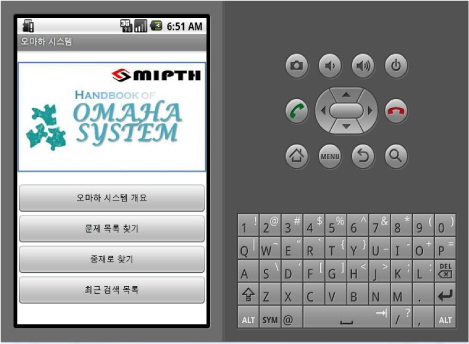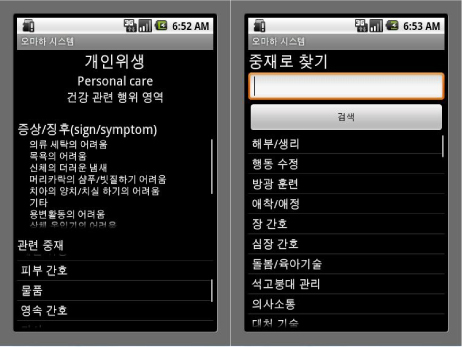J Korean Acad Community Health Nurs.
2010 Dec;21(4):512-521. 10.12799/jkachn.2010.21.4.512.
Developing a Smart Phone Application for the OMAHA System Guidelines
- Affiliations
-
- 1College of Nursing, Kyungpook National University, Korea.
- 2Department of Medical Informatics, Kyungpook National University, Korea.
- 3MIPTH, Kyungpook National University, Korea. pulala@paran.com
- KMID: 2292881
- DOI: http://doi.org/10.12799/jkachn.2010.21.4.512
Abstract
- PURPOSE
The remarkable progress in information and communication technology has had a great effect on the healthcare delivery system. The development of smart phone applications is a new field. The aim of our research was to provide assistance in developing smart phone applications for community health nursing.
METHODS
Based on an informative approach, this study developed persona and site maps, followed by a storyboard as a way of analyzing users' requirements and designing responses in the context of smart phone application development methodology.
RESULTS
We developed persona, user interface and database design successfully, and then seven nurses selected four nursing problems (income, residence, pain, and digestion hydration). The search time in seconds for the 2005 English OMAHA guidelines to find three nursing interventions for these problems was used to evaluate the effectiveness of the smart phone application. The results showed that smart phone applications' search was 21 times faster on the average than book guidelines.
CONCLUSION
An English version of the OMAHA system application was developed for the Android smart phone market. It is hoped that smart phone applications such as this will be used internationally for nursing education.
MeSH Terms
Figure
Reference
-
1. Korea Internet & Security Agency. 2009-2010 The Korea mobile yearbook. Seoul: I News;2009.2. American Nurses Association. Recognized languages for nursing. 2009. 09. 27. Retrieved October 18, 2010. from http://www.nursingworld.org.3. Androwich IM, Bickford CJ, Button PS, Hunter KM, Murphy J, Sensmeier J. Clinical information systems: A framework for reaching the vision. Washington DC: ANA Publishing;2003.4. Barton AJ, Gilbert L, Erickson V, Baramee J, Sowers D, Robertson KJ. A guide to assist nurse practitioners with standardized nursing language. Comput Inform Nurs. 2003; 21(3):128–133.
Article5. Beck K. Test driven development: By example. Massachusetts: Addison-Wesley Professional;2002.6. Canham D, Mao CL, Yoder M, Connolly P, Dietz E. The Omaha system and quality measurement in academic nurse-managed centers: Ten steps for implementation. J Nurs Educ. 2008; 47(3):105–110.
Article7. Ciemins E, Coon P, Sorli C. An analysis of data management tools for diabetes self-management: Can smart phone technology keep up? J Diabetes Sci Technol. 2010; 4(4):958–960.
Article8. Cho WJ, Yoo IY, Chae SM, Ham OK, Seo KM. Needs assessment of community health service using OMAHA system. Korean J Nurs Query. 2002; 11(1):168–190.9. Correll PJ, Martin KS. The omaha system helps a public health nursing organization find its voice. Comput Inform Nurs. 2009; 27(1):12–16.
Article10. De Leo G, Gonzales CH, Battagiri P, Leroy GA. A smart-phone application and a companion website for the improvement of the communication skills of children with autism: Clinical rationale, technical development and preliminary results. J Med Syst. 2011; 08. 35(4):703–711. Retrieved November 30, 2010, from http://www.springerlink.com/content/5q574hl40p71234n/fulltext.pdf.
Article11. Garvin JH, Martin KS, Stassen DL, Bowles KH. The Omaha System. Coded data that describe patient care. J AHIMA. 2008; 79(3):44–49.12. Greiner AC, Knebel E, editors. Health professions education: A bridge to quality. Washington DC: National Academies Press;2003.13. Hamner J, Wilder B. A new curriculum for a new millennium. Nurs Outlook. 2001; 49(3):127–131.
Article14. Hardiker NR, Hoy D, Casey A. Standards for nursing terminology. J Am Med Inform Assoc. 2000; 7(6):523–528.
Article15. Harris MR, Graves JR, Solbrig HR, Elkin PL, Chute CG. Embedded structures and representation of nursing knowledge. J Am Med Inform Assoc. 2000; 7(6):539–549.
Article16. Hunter T, Hardwicke J, Rayatt S. The smart phone: An indispensable tool for the plastic surgeon? J Plast Reconstr Aesthet Surg. 2010; 63(4):e426–e427.
Article17. Kim SH. Effects of perceived attributes on the purchase intention of smart phone. J Korea Contents Assoc. 2010; 10(9):318–326.18. Lang NM. Nursing data systems: The emerging framework. Washington DC: American Nurses Publishing;1995.19. Lee SH, Im MJ, Lee KY. Healthcare application modeling using smart phone. J Inst Webcasting Internet Telecommun. 2010; 10(4):35–40.20. Martin KS. The Omaha system: A key to practice, documentation, and information management. 2nd ed. Nebraska: Health Connections Press;2004.21. Plowfield LA, Hayes ER, Hall-Long B. Using the Omaha System to document the wellness needs of theelderly. Nurs Clin North Am. 2005; 40(4):817–829. xiii22. Tanner CA. The times they are a-changing. J Nurs Educ. 1995; 34(6):247.23. Westra BL, Oancea C, Savik K, Marek KD. The feasibility of integrating the Omaha system data across home care agencies and vendors. Comput Inform Nurs. 2010; 28(3):162–171.
Article24. Westra BL, Solomon D, Ashley DM. Use of the Omaha System data to validate Medicare required outcomes in home care. J Healthc Inf Manag. 2006; 20(3):88–94.25. Yom YH, Kim JE, Chun CC, Choi SW, Whang DH, Park KM, et al. Development of standardized and competency-based curriculum in nursing informatics. J Korean Soc Med Inform. 2007; 13(3):227–236.
Article26. Yoo IY, Cho WJ, Chae SM, Kim MJ. Community health service needs assessment in Korea using OMAHA Classification System. Int J Nurs Stud. 2004; 41(6):697–702.
Article
- Full Text Links
- Actions
-
Cited
- CITED
-
- Close
- Share
- Similar articles
-
- Development Scenario of Dietary Intake Survey Using Internet of Things (IoT)
- Weight Control Program through the Fortification of Food Consumption Monitoring on Obese Female College Students: Using Smart-Phone with Real Time Communication Application
- The Difference of Body Mass Index According to Smart Phone Proficiency in Koreans over the Age of 60
- The Effect of Behavior Inhibition System on Smart-Phone Addiction : The Mediation Roll of Depression
- Effects of a Smart Phone Individualized Distraction Intervention on Anxiety in Pre-Op Pediatric Patients






